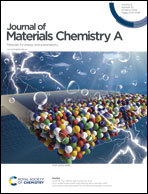Unlocking the potential of coinage-based quaternary chalcogenides for thermoelectricity†
Abstract
The pursuit of thermoelectric materials poses a formidable challenge, given that numerous predicted candidates fail in real-world applications. An effective way to enhance the success rate of computer predictions is to focus on key elements shared by workable thermoelectrics. These elements include chalcogens (Q = S and Se), pentagons (III = ![[double bond, length as m-dash]](https://www.rsc.org/images/entities/char_e001.gif) As, Sb, and Bi), coinage metals (I =
As, Sb, and Bi), coinage metals (I = ![[double bond, length as m-dash]](https://www.rsc.org/images/entities/char_e001.gif) Cu, Ag, and Au), and post-transition metals (III/IV =
Cu, Ag, and Au), and post-transition metals (III/IV = ![[double bond, length as m-dash]](https://www.rsc.org/images/entities/char_e001.gif) Ga, In, Ge, Sn, Pb). Here, we screen two types of coinage-based quaternary chalcogenides possessing these crucial thermoelectric elements: I–II–IV–Q4 and I–II2–III–Q4. We found that the thermoelectric performance of these compounds originates from the unconventional I–Q bonding formed through strong coupling between the coinage d and chalcogen p orbitals. The d–p hybridization forms a filled antibonding state at the top of the valence band that not only weakens the I–Q bonds, which lowers the lattice thermal conductivity, but also generates a flat-and-dispersive and multi-valley degenerate valence band, resulting in a high p-type power factor. So, the higher the share of coinage metals and thus the I–Q bonding within the unit cell, the lower the lattice thermal conductivity is. Such soft I–Q bonds, when accompanied by breakage of local symmetry and corner-sharing tetrahedral units, suppress the lattice thermal conductivity down to the amorphous limit. For instance, Ag2PbGeS4 demonstrates a lattice thermal conductivity of 0.15 W m−1 K−1 because of various anharmonic scattering processes caused by lone-pair-induced off-centering of Pb, weak Ag–Ag interactions, and disrupted corner-sharing networks, the combination that yields a zT exceeding two. Our findings highlight the potential of coinage-based quaternary chalcogenides as practical thermoelectric materials, paving the way for the development of customizable thermoelectrics.
Ga, In, Ge, Sn, Pb). Here, we screen two types of coinage-based quaternary chalcogenides possessing these crucial thermoelectric elements: I–II–IV–Q4 and I–II2–III–Q4. We found that the thermoelectric performance of these compounds originates from the unconventional I–Q bonding formed through strong coupling between the coinage d and chalcogen p orbitals. The d–p hybridization forms a filled antibonding state at the top of the valence band that not only weakens the I–Q bonds, which lowers the lattice thermal conductivity, but also generates a flat-and-dispersive and multi-valley degenerate valence band, resulting in a high p-type power factor. So, the higher the share of coinage metals and thus the I–Q bonding within the unit cell, the lower the lattice thermal conductivity is. Such soft I–Q bonds, when accompanied by breakage of local symmetry and corner-sharing tetrahedral units, suppress the lattice thermal conductivity down to the amorphous limit. For instance, Ag2PbGeS4 demonstrates a lattice thermal conductivity of 0.15 W m−1 K−1 because of various anharmonic scattering processes caused by lone-pair-induced off-centering of Pb, weak Ag–Ag interactions, and disrupted corner-sharing networks, the combination that yields a zT exceeding two. Our findings highlight the potential of coinage-based quaternary chalcogenides as practical thermoelectric materials, paving the way for the development of customizable thermoelectrics.



 Please wait while we load your content...
Please wait while we load your content...